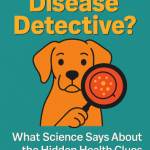
When Your Dog Eats Chocolate: What to Do and Why It Matters
Most dog owners know chocolate is toxic to dogs, but do you know why? What actually happens when a dog eats chocolate? And, if your dog gets into your candy stash, how serious could it be? Recent research helps answer these questions by analyzing cases of chocolate ingestion in dogs. Understanding the science behind chocolate poisoning will not only ease your mind but also help you take quick and effective action if the worst happens.
Chocolate and Dogs: A Dangerous Combination
Chocolate contains two chemicals, theobromine and caffeine, both of which are part of a group called methylxanthines. These chemicals are the culprits behind chocolate’s toxicity in dogs. While humans can break down and get rid of these chemicals fairly quickly, dogs process them much more slowly, meaning theobromine and caffeine stick around in a dog’s system for longer, potentially causing harm.
The concentration of these chemicals in chocolate varies by type. Dark chocolate and baking chocolate contain the highest amounts of theobromine, while milk chocolate has significantly less. White chocolate, for all the dog parents out there, is essentially harmless as it contains negligible amounts of theobromine.
What Happens When a Dog Eats Chocolate?
The study examined 156 dogs brought to the vet after eating chocolate. Interestingly, 112 of these dogs showed no signs of illness, likely because they consumed a smaller amount of chocolate or milk chocolate, which is less toxic. However, the remaining 44 dogs displayed symptoms of chocolate poisoning.
The severity of symptoms depended on the amount and type of chocolate ingested. Dark and bitter chocolate, which have high levels of theobromine, were behind most cases of more serious illness. Some dogs experienced mild symptoms like agitation, panting, and vomiting. Others showed more concerning signs such as tremors, rapid heart rate, and dehydration.
One important factor in whether a dog gets sick is timing. Dogs that received treatment shortly after ingestion generally fared much better. This is why it’s so important to seek veterinary care as soon as you know your dog has eaten chocolate, especially if you’re unsure of the amount or type consumed.
Symptoms to Watch For
If your dog eats chocolate, here are the key symptoms to watch for:
- Restlessness or agitation: Your dog may seem unusually hyper or unable to settle down.
- Tremors: Uncontrolled shaking or trembling could indicate a more serious response to theobromine.
- Vomiting and diarrhea: Chocolate, particularly if it’s high in fat, can upset a dog’s digestive system.
- Rapid heart rate: You might notice your dog panting or breathing heavily. If you have access to a stethoscope, you can check for an unusually fast heartbeat.
- Increased urination: Theobromine can act as a diuretic, meaning your dog may need to pee more than usual.
The study noted that 43 of the 44 dogs with symptoms survived after receiving treatment, highlighting the importance of seeking immediate veterinary care.
How Chocolate Poisoning Is Treated
If you think your dog has eaten chocolate, the best course of action is to call your vet immediately. In most cases, the vet will try to get the chocolate out of the dog’s system quickly, often by inducing vomiting. Activated charcoal might also be used to prevent further absorption of theobromine.
For dogs with more severe symptoms, treatment may include fluids to prevent dehydration and medications to control their heart rate and prevent seizures. While the situation might seem scary, the prognosis is generally good, with less than 3% of dogs suffering fatal consequences from chocolate ingestion.
Timing Matters: When to Act Fast
The timing between chocolate ingestion and veterinary treatment is crucial. Dogs that received prompt treatment—ideally within a few hours—were much more likely to recover without any long-term effects. Theobromine can take several hours to reach peak levels in a dog’s bloodstream, so the sooner your vet can intervene, the better.
A dog who ingests chocolate is most likely to develop symptoms within two to four hours. If your dog has eaten dark or baking chocolate, or you’re unsure how much chocolate they’ve eaten, it’s important to act fast. Even if your dog seems fine initially, it’s better to be safe than sorry.
Why December Is the Riskiest Time for Dogs
Interestingly, the study found that most cases of chocolate ingestion happened during December, likely due to the increased availability of chocolate around the holidays. Think of all those festive treats, gift boxes, and stockings within easy reach of curious dogs. Easter is another time of year when chocolate-related incidents peak. The takeaway? Keep an extra close eye on your pets during these times when chocolate is more readily available in your home.
Preventing Chocolate Poisoning
Prevention is the best strategy when it comes to chocolate poisoning. Here are a few tips to keep your dog safe:
- Store chocolate out of reach: This seems simple, but it’s easy to leave a chocolate bar on the coffee table or a wrapped gift under the tree. Make sure chocolate is stored where your dog can’t get it.
- Educate guests: If you’re hosting friends or family, make sure they know not to leave chocolate or desserts where pets can access them.
- Use pet-proof containers: Consider storing chocolate in containers that your dog can’t easily open.
- Know the signs: If your dog does get into chocolate, knowing the symptoms of chocolate poisoning can help you act quickly.
Join the Conversation
Has your dog ever eaten chocolate? How did you handle it? Share your experiences or thoughts in the comments below. Let’s discuss how we can better protect our pets from common household dangers like chocolate!
Conclusion: Chocolate and Dogs Don’t Mix—But Quick Action Saves Lives
While chocolate poisoning in dogs can be a serious issue, most dogs recover with prompt treatment. The key is to act quickly and get your pet to the vet if you suspect they’ve consumed chocolate. With proper care, the vast majority of dogs bounce back without any lasting effects. So while it’s critical to be cautious, you can feel confident that knowing what to do will keep your furry friend safe and healthy.




